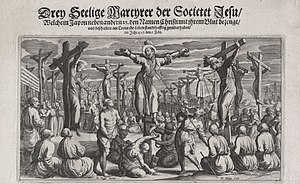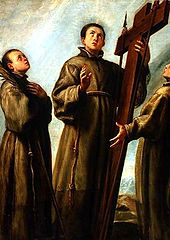Gonsalo Garcia
Gonsalo Garcia often also Gundisalvus Garcia or Gonzalo Garcia (* 1556 in Vasai near Bombay , India , † February 5, 1597 in Nagasaki , Japan ) was an Indian Franciscan lay brother who died as a martyr in Japan. He is a saint of the Catholic Church and the first Indian to be officially beatified in 1627 and canonized in 1862 .
Life
In India
Gonsalo Garcia was the son of a Portuguese resident in India and his Indian wife, a Canaresin . Gundi Slavus Garcia has been passed down as the child's real name . Vasai's native town, then called Bassein, was a Portuguese base with a fortress and a church. Garcia is a typical representative of the Indian ethnic group of so-called Goa Catholics in terms of origin and social environment .
The Portuguese Jesuit Father Sebastian Gonsalves became his patron and he also taught him from 1564 to 1572 in the Order College of Vasai. In April 1572 he took the 15-year-old boy with him as an assistant on the Japan mission to Nagasaki.
In the Far East
Gonsalo Garcia quickly learned Japanese and worked as a keen catechist among the new Christians there. He wanted to become a Jesuit, but the order no longer accepted Indians and half-Indians.
Nevertheless, he remained loyal to the missionaries and the Christian community. He went to Macau as a trader and interpreter for the Portuguese there. He also continued to work as a lay apostle. Finally, in 1583, he traveled to the Philippines to Manila . Here he used to a. Lepers and met the Spanish Franciscan Father Peter Baptista, who suggested that he join his order of the Franciscan Minorites if the spiritual life was his desire.
Garcia accepted this offer, which fulfilled his original intention. In 1587 he entered the novitiate and on July 3, 1588 he made perpetual vows as a friar. Since he spoke Japanese well, the Filipino ambassador selected him as an interpreter for a diplomatic mission in Japan. His tutor, Father Pedro Baptista, also accompanied them. So the Indian came back to Japan and stayed here as a Franciscan. Because of his solid economic knowledge, he was given the internal task of examining and implementing new projects. So he founded a leprosy home in Kyoto and a monastery in Osaka .
In 1596 a wave of persecution of Christians began in Japan. On December 8th of that year the Franciscan Minorites were placed under house arrest in their monastery in Kyoto and arrested a few days later. In addition to the Spanish Superior Father Pedro Baptista and Brother Gonsalo Garcia, there were the three Spanish priests Martin de Aguiar, Francis Blanco and Francis de St. Michael as well as another lay brother named Philip de las Casas from Mexico . In prison they met with other captured Catholics, namely the Japanese Jesuits Paul Miki , John Gotto and James Kisai, as well as several lay people. There were a total of 26 people, including three acolytes between the ages of 12 and 14.

Since the Christians persistently refused to renounce their faith, they were brought to the main square of Kyoto and publicly cut off a piece of their left ear. They were then led around to mockery, announced their crimes, and called on the local population to abuse the prisoners. Eventually they were abducted to Nagasaki, drove them to the Tateyama Hill (Wheat Mountain) in the very cold winter, and crucified them all together.
It is reported of Gonsalo Garcia that he was the first to arrive at a prepared cross and asked a guard if it was his. He denied it and sent him to someone else, whom he kissed and then had himself nailed to it. The 26 crosses with the Christians nailed to the ground were raised at the same time. In order to kill all of the crucified ones after a while, the rib cage on both sides of the body was pierced with a lance from the lowest rib to the shoulder blade .
Adoration

From the beginning, the crucified were venerated as martyrs. They were called "Paul Miki and Companions" or the " Martyrs of Nagasaki " . On September 14, 1627, Pope Urban VIII beatified the Indian Gonsalo Garcia and all the other martyrs of Nagasaki, and on June 8, 1862 he was canonized by Pope Pius IX. Her liturgical feast day is February 6th . In 1942, a new church was built in his honor in the Indian birthplace of Gonsalo Garcias; he is also the patron saint of the Vasai diocese, established in 1998 .
literature
- Francis Correa: "Missionary Heralds of India" . St. Paul Society, Bombay 2010, ISBN 978-93-5015-014-6 , pp. 82-89.
Web links
- The Martyrs of Nagasaki in the Ecumenical Lexicon of Saints portal ; with a mention by name of Gonsalo Garcia
- Vasai Diocese website about the saint
- Website of the Memorial of the 26 Martyrs of Nagasaki
Individual evidence
- ↑ Website about the history of the Catholics in Vasai ( Memento of the original from January 25, 2004 in the Internet Archive ) Info: The archive link has been inserted automatically and has not yet been checked. Please check the original and archive link according to the instructions and then remove this notice.
- ^ Catholic Encyclopedia, 1912, Sts. Peter Baptist and Twenty-Five Companions. Online view of the source
- ↑ Illustrated website on the parish of St. Gonsalo Garcia in Vasai ( Memento of the original from December 10, 2013 in the Internet Archive ) Info: The archive link was inserted automatically and has not yet been checked. Please check the original and archive link according to the instructions and then remove this notice.
- ^ Newspaper article from the Times of India
| personal data | |
|---|---|
| SURNAME | Garcia, Gonsalo |
| ALTERNATIVE NAMES | Garcia, Gundisalvus; Garcia, Gonzalo |
| BRIEF DESCRIPTION | Indian Franciscan lay brother |
| DATE OF BIRTH | 1556 |
| PLACE OF BIRTH | Vasai near Bombay , India |
| DATE OF DEATH | February 5, 1597 |
| Place of death | Nagasaki , Japan |

